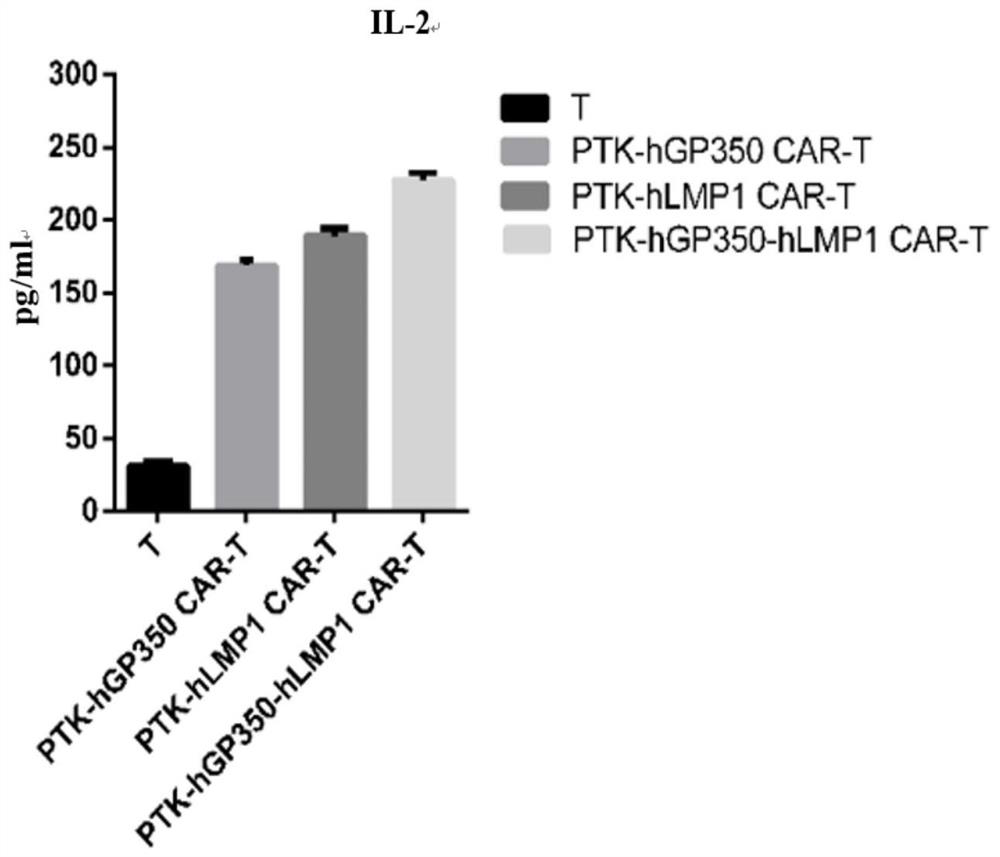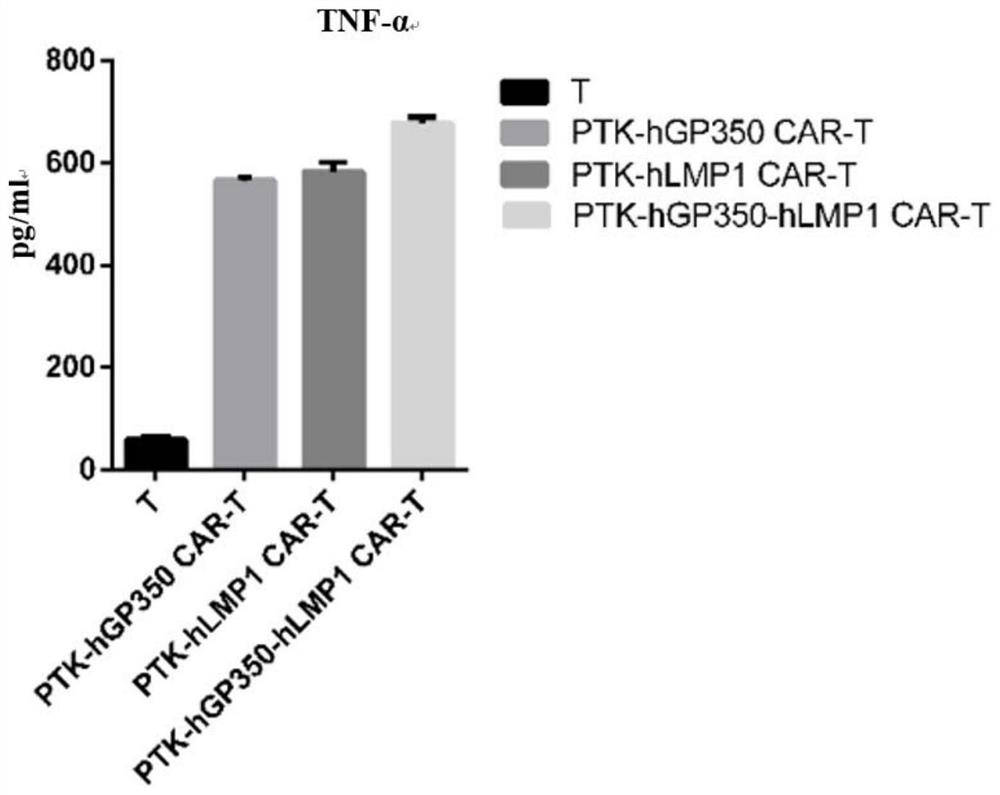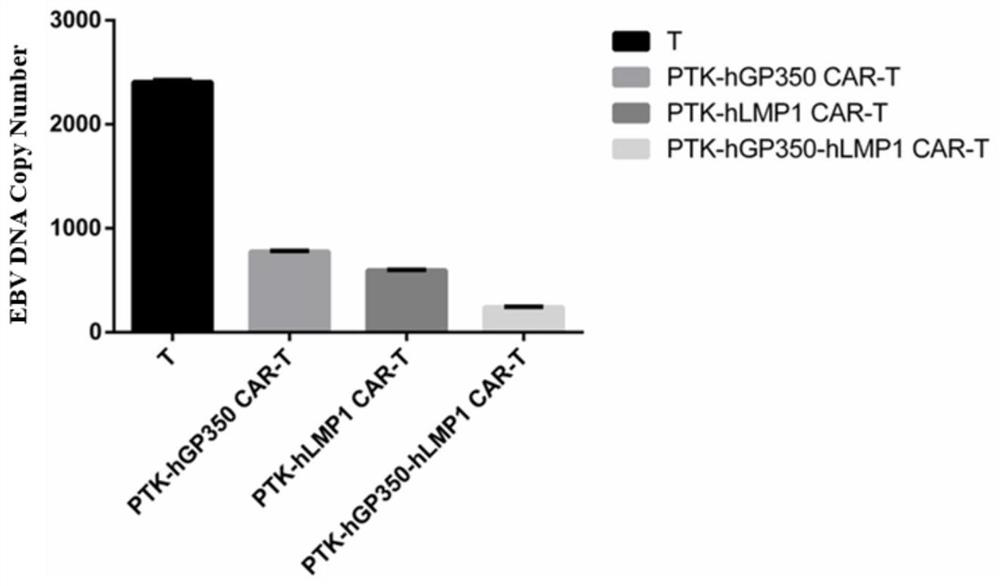Double-target chimeric antigen receptor (CAR) targeting LMP1 and GP350 simultaneously and application of double-target CAR
A chimeric antigen receptor and dual-target technology, which is applied in the direction of targeting specific cell fusion, polypeptides containing positioning/targeting motifs, applications, etc., can solve problems such as off-target effects and achieve low levels of secreted cytokines , improved conversion rate, and ideal results
- Summary
- Abstract
- Description
- Claims
- Application Information
AI Technical Summary
Problems solved by technology
Method used
Image
Examples
Embodiment 1
[0024] Example 1 Dual-target CART plasmid construction
[0025] Plasmid construction
[0026] The gene sequence fragments were sequentially synthesized and connected: light chain of anti-GP350 single-chain antibody, heavy chain of anti-GP350 single-chain antibody, light chain of anti-LMP1 single-chain antibody, heavy chain of anti-LMP1 single-chain antibody, CD8α hinge region, CD28 span Membrane and intracellular domains, 4-1BB intracellular domain, and CD3ζ intracellular domain. The fragments were synthesized by Jinweizhi Company. The obtained gene sequence fragment was connected to the universal lentiviral expression vector PTK881 with restriction sites Age I and Afe I to obtain the plasmid PTK-hGP350-hLMP1 capable of simultaneously expressing LMP1 and GP350 dual-target CAR. The connection steps were completed by Jinweizhi Biotechnology Co., Ltd.
[0027] The constructed plasmid also includes the signal peptide sequence before the light chain of the anti-GP350 single-chai...
Embodiment 2
[0033] Example 2 Construction of CAR-T cells
[0034] Lentivirus packaging: Insert a certain number of 293T cells into a petri dish with a diameter of 10 cm, add 10 mL of DMEM complete medium, and culture several dishes in an incubator containing 5% CO2 at 37°C. When the 293T cells cover about 90% of the culture dish, add 100 μl of DMEM low-sugar medium mixed with 16 μg of the three-plasmid packaging system to the tube of DMEM low-sugar medium containing 48 μl of PEI transfection reagent, vortex, and mix thoroughly. Incubate at 37°C for 30min. Drop the mixture obtained above into a 10cm petri dish, and place it in an incubator containing 5% CO2 at 37°C for culture, change the medium after 6-8 hours, remove all the medium in the 10cm petri dish, add new 10ml DMEM to completely Medium. After 3 days, the cell culture supernatant was collected and filtered through a 0.45 μm filter membrane to obtain the virus initial solution. The three-plasmid packaging system in this example ...
Embodiment 3
[0062] Example 3 Detection of transduction efficiency
[0063] After transducing CAR-T cells, the transduction efficiency of PTK-hGP350-hLMP1 CAR-T cells can be detected, as follows:
[0064] Take 1.0×10 6 After transduction, T cells were incubated with Goat anti-Hμman IgG Antibody and FITC conjμgate at room temperature for 30 minutes, washed twice with normal saline, and the FITC fluorescence signal was detected by flow cytometry, and the ratio of FITC-positive cells was measured. Table 2 reflects the transduction conduction efficiency.
[0065] transduction type transduction efficiency PTK-hGP350-hLMP1 CAR-T cells 29.8% PTK-hGP350CAR-T cells 32.5% PTK-hLMP1 CAR-T cells 33.1%
[0066] Table 2
PUM
 Login to View More
Login to View More Abstract
Description
Claims
Application Information
 Login to View More
Login to View More - R&D
- Intellectual Property
- Life Sciences
- Materials
- Tech Scout
- Unparalleled Data Quality
- Higher Quality Content
- 60% Fewer Hallucinations
Browse by: Latest US Patents, China's latest patents, Technical Efficacy Thesaurus, Application Domain, Technology Topic, Popular Technical Reports.
© 2025 PatSnap. All rights reserved.Legal|Privacy policy|Modern Slavery Act Transparency Statement|Sitemap|About US| Contact US: help@patsnap.com



